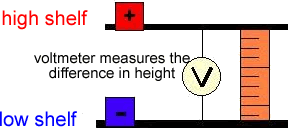Potential
Difference
Potential difference measures the work done per unit charge
The potential difference (voltage) between two points in an electric circuit is the work done (energy transferred) per coulomb of charge that passes between the points.
V = W/Q
so:
W = VQ
A volt is a 'joule per coulomb' OR a coulomb is a 'joule per volt'

What matters most to an electron?
If
you were an electron you would have 'charge' as well as 'mass'.
The force exerted on your mass by gravity would be negligible compared to the electrostatic force that you would experience because you were charged.
You would
therefore not be very bothered by the 'ups and downs' in the physical dimension around you - hills and dales, slopes and steps - because the
force of gravity does not have a very big effect on you.... but the proximity of any charged object would have a big effect on you - negative charge would repel you strongly and positive charge would attract you.
 Click
here for the calculation
Click
here for the calculation
Don't worry if it looks hard, it is hard maths (not needed until
A level)... just look at the answer!
Scientific Model
A scientific model
is like a scientific parable.... whereas a parable is an earthly story
with a heavenly (spiritual) meaning, a scientific model is an earthly
description in everyday terms with a deeper scientific meaning. Just
as the analogy of a parable can't be taken too literally, so the model
can't.... but its basic features help us to understand how something
behaves.
A Scientific
Model for Electric Potential
The fact that you
are charged makes you susceptible to changes in something we call electric
potential gradient .
The bigger the change
in gradient the bigger push you experience
from the electric force.
You therefore have
to think of potential difference as an 'electric slope' that charged particles
slide down .

 - the bigger the
potential difference the 'steeper this slope' and therefore the bigger
the force or push they receive.
- the bigger the
potential difference the 'steeper this slope' and therefore the bigger
the force or push they receive.
 - the bigger the
charge on the particle the more charge moves each time therefore the bigger the current.
- the bigger the
charge on the particle the more charge moves each time therefore the bigger the current.
 - the bigger the
potential gradient for an electron in a wire the faster it moves, so
the bigger the current flow (as current is rate of flow of electrons
in a wire)
- the bigger the
potential gradient for an electron in a wire the faster it moves, so
the bigger the current flow (as current is rate of flow of electrons
in a wire)
The voltmeter
This is an instrument
for measuring potential difference. It measures the difference in electrical
height between to levels of electric potential. Each of these are in
volts, so it measures potential difference in volts.

Try these questions:
Q1. A component has a potential drop of 4.0 V across it. This makes a current of 0.25A flow through it. What current will flow if the drop is increased to 8.0 volts?
Q2. A component has a potential drop of 3.0 V across it. This makes a current of 0.15 A flow through it. What potential drop must be across the component if the current flowing through it drops to 0.05 A?
Click here for the
answers
 NOW LOOK AT POTENTIAL
DIVISION - IT TAKES THE TOPIC FURTHER
NOW LOOK AT POTENTIAL
DIVISION - IT TAKES THE TOPIC FURTHER









